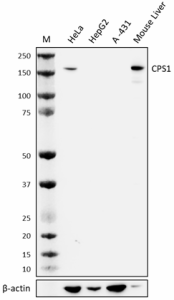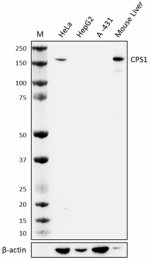- Clone
- W21062G (See other available formats)
- Regulatory Status
- RUO
- Other Names
- Carbamoyl-Phosphate Synthetase I, Carbamoyl-Phosphate Synthase 1, Carbamoyl-Phosphate Synthase 1, Mitochondrial, Carbamoyl-Phosphate Synthase [Ammonia], Mitochondrial, CPSase I, CPSase 1
- Isotype
- Rat IgG2a, κ
- Ave. Rating
- Submit a Review
- Product Citations
- publications

-

Whole cell extracts (15 µg total protein) from indicated cell lines and tissue were resolved by 4-12% Bis-Tris gel electrophoresis, transferred to a PVDF membrane, and probed with 0.25 µg/mL of purified anti-CPS1 (clone W21062G) overnight at 4°C. Proteins were visualized by chemiluminescence detection using HRP Goat anti-rat IgG (Cat. No. 405405). Direct-Blot™ HRP anti-β-actin (Cat. No. 664804) was used as a loading control at a 1:50000 dilution. Western-Ready™ ECL Substrate Premium Kit (Cat. No. 426319) was used as a detection agent. Lane M: Molecular weight marker -

HeLa cells were stained with 500 nM of MitoSpy™ Red CMXRos (Cat. No. 424802) (panel A, pseudo color green) for 30 minutes at 37°C, fixed with Fixation Buffer (Cat. No. 420801) for 10 minutes and permeabilized with 0.5% Triton X-100 for 10 minutes, and blocked with 5% FBS for 1 hour at room temperature. Cells were then stained with 10.0 µg/mL of purified anti-CPS1 (clone W21062G), followed by incubation with Alexa Fluor® 647 Goat anti-rat IgG (Cat. No. 405416) (panel B, magenta) for 1 hour at room temperature. Cells were also stained with Flash Phalloidin™ Green 488 (Cat. No. 424201) (panel C, pseudo color yellow) and nuclei were counterstained with DAPI (Cat. No. 422801) (panel D, blue). Images were merged (panel D). The images were captured by a Revvity Operetta CLS™ High Content Analysis System with a 63X objective. Scale bar: 50 µm -

HeLa cells were stained with 500 nM of MitoSpy™ Red CMXRos (Cat. No. 424802) (panel A, pseudo color green) for 30 minutes at 37°C, fixed and permeabilized with methanol for 10 minutes, and blocked with 5% FBS for 1 hour at room temperature. Cells were then stained with 5.0 µg/mL of purified anti-CPS1 (clone W21062G), followed by incubation with Alexa Fluor® 647 Goat anti-rat IgG (Cat. No. 405416) (panel B, magenta) for 1 hour at room temperature. Nuclei were counterstained with DAPI (Cat. No. 422801) (panel C, blue). Images were merged (panel D). The images were captured by a Revvity Operetta CLS™ High Content Analysis System with a 63X objective. Scale bar: 50 µm -

IHC staining of purified anti-CPS1 (clone W21062G) on formalin-fixed paraffin-embedded human liver tissue. Following antigen retrieval using Tris-EDTA (10 mM Tris, 1 mM EDTA, pH 9.0), the tissue was incubated with 0.5 µg/mL of purified anti-CPS1 (clone W21062G) followed by incubation with Alexa Fluor® 647 Goat anti-rat IgG (Cat. No. 405416) for 1 hour at room temperature. Nuclei were counterstained with DAPI (Cat. No. 422801). Images were captured with a 10X (panel A) or 40X objective (panel B). Scale bar: 50 µm
| Cat # | Size | Price | Quantity Check Availability | Save | ||
|---|---|---|---|---|---|---|
| 630751 | 25 µg | 132€ | ||||
| 630752 | 100 µg | 332€ | ||||
CPS1, or carbamoyl phosphate synthase 1, catalyzes the initial step in the urea cycle to produce carbamoyl phosphate from ammonia and bicarbonate. CPS1 is highly expressed in the mitochondria of hepatocytes, where a robust urea cycle takes place to detoxify ammonia from protein catabolism. CPS1 deficiency in humans is an autosomal recessive disease that causes severe symptoms, such as hyperammonemia, in urea cycle disorders. This deficiency affects the neuronal and metabolic development of newborn children. CPS1 undergoes various post-translational modifications, including acetylation, succinylation, and glutarylation, which regulate the enzymatic activity of CPS1. During fasting, sirtuin 5 (SIRT5) is activated by increased NAD levels, leading to the deacetylation and deglutarylation of CPS1. This process removes inhibitory modifications from the active ATP binding site. The tumor suppressor p53 regulates ammonia metabolism by repressing the urea cycle and the expression of genes such as CPS1, OTC, and ARG1. The repression leads to the inhibition of ureagenesis and the elimination of ammonia, ultimately impacting tumor growth.
Product DetailsProduct Details
- Verified Reactivity
- Human, Mouse
- Antibody Type
- Monoclonal
- Host Species
- Rat
- Immunogen
- Recombinant fragment of human CPS1
- Formulation
- Phosphate-buffered solution, pH 7.2, containing 0.09% sodium azide
- Preparation
- The antibody was purified by affinity chromatography.
- Concentration
- 0.5 mg/mL
- Storage & Handling
- The antibody solution should be stored undiluted between 2°C and 8°C.
- Application
-
WB - Quality tested
ICC, IHC-P - Verified - Recommended Usage
-
Each lot of this antibody is quality control tested by western blotting. For western blotting, the suggested use of this reagent is 0.25 - 1.0 µg/mL. For immunocytochemistry, a concentration range of 1.0 - 10.0 μg/mL is recommended. For immunohistochemistry on formalin-fixed paraffin-embedded tissue sections, a concentration range of 0.25 - 1.0 µg/mL is suggested. It is recommended that the reagent be titrated for optimal performance for each application.
- Application Notes
-
For immunocytochemistry (ICC), the recommended fixation/permeabilization method is either 4% paraformaldehyde/0.5% Triton X-100, paraformaldehyde followed by ice-cold methanol, or ice-cold methanol fixed only.
For immunohistochemistry (IHC), the recommended antigen retrieval system is either Citrate Buffer, 10X (Cat. No. 420902) or Tris-EDTA pH 9.0 buffer. - RRID
-
AB_3083419 (BioLegend Cat. No. 630751)
AB_3083419 (BioLegend Cat. No. 630752)
Antigen Details
- Structure
- 3 isoforms exist/form homodimer and homooligomer
- Distribution
-
Liver and small intestine/mitochondria
- Function
- Catalyzes the urea cycle of ureotelic animals and remove excess ammonia from the cell
- Interaction
- Post-translational modification by SIRT5/Catalyze ammonia and bicarbonate to carbamoyl phosphate
- Biology Area
- Apoptosis/Tumor Suppressors/Cell Death, Cell Biology, Cell Proliferation and Viability, Mitochondrial Function, Neuroscience
- Molecular Family
- Enzymes and Regulators, Mitochondrial Markers
- Antigen References
-
- Nakagawa T, et al. 2009. Cell. 137(3):560-70.
- Diez-Fernandez C, et al. 2017. Expert Opin. Ther. Targets. 21:391-399.
- Li L, et al 2019. Nature. 567:253-256.
- Nitzahn M, et al. 2020. Mol Genet Metab. 131:289-298.
- Gene ID
- 1373 View all products for this Gene ID
- UniProt
- View information about CPS1 on UniProt.org
Related FAQs
Other Formats
View All CPS1 Reagents Request Custom Conjugation| Description | Clone | Applications |
|---|---|---|
| Purified anti-CPS1 | W21062G | WB,IHC-P,ICC |
Compare Data Across All Formats
This data display is provided for general comparisons between formats.
Your actual data may vary due to variations in samples, target cells, instruments and their settings, staining conditions, and other factors.
If you need assistance with selecting the best format contact our expert technical support team.
 Login / Register
Login / Register 











Follow Us